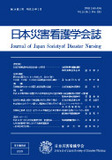Japanese
English
- 有料閲覧
- Abstract 文献概要
- 参考文献 Reference
抄録
本研究は、乳幼児の看護に従事する看護職を対象に、災害に対する意識を明らかにし、災害時における対応能力の育成を図るプログラムを検討することを目的に、2010年2月〜5月、首都圏および新潟県中越地区、関西地区の病院の看護職を対象に、病院等での防災訓練への参加の有無や入院児の避難場所に関する知識を問う質問紙調査を行った。倫理的配慮として、依頼文に研究
の目的、方法について説明を記し、返信をもって同意を得たものとした。分析は、記述統計およびχ検定を行った。有効回答数は503部であった。災害時、乳幼児の避難場所を知っている者は353名で70.4%を占めたが、知らない者も149名あった。避難場所を知らない者は、病院・病棟での防災、避難訓練に参加していない割り合いが、避難場所を知っている者に比較して有意に高く、また、病棟の防災マニュアルを読んだことがないと答えていた。避難場所を知っているか否
かと各自の被災体験や災害看護の経験については有意差を認めなかった。乳幼児が医療機関で被災した場合、生命の安全は全面的に看護者にゆだねられるが、看護職が避難場所を知らなければ、重大な混乱を招く。これを防ぐには、臨床現場での防災訓練や災害看護の現任教育が重要であることが示唆された。危機管理の一環として、日常の看護業務とともに防災、避難訓練を積んでお
くことが不可欠である。
Abstract
In this study,a questionnaire survey was conducted from February to May 2010 to clarify the disaster prevention awareness of nursing staff caring for babies and infants and to support the implementation of a program to improve the disaster-response capabilities of such workers. The subjects were nursing personnel working in hospitals in the metropolitan area and the Chuetsu district of Niigata Prefecture and the Kansai region of Japan. Subjects were asked about their history of participation in hospital disaster drills and their knowledge of evacuation locations where babies and infants should be taken in the event of an emergency. In terms of ethical consideration,the purpose and method of the survey were outlined in the written questionnaire participation request,and staff returning the questionnaire were deemed to have consented to the survey. The related data analysis was based on descriptive statistics and Chi-square testing. The total number of valid questionnaires returned was 503. Among these,353 respondents(70.4%)knew where their designated evacuation point was,and 149 did not. This group of 149 exhibited a significantly higher ratio of individuals who had never participated in a disaster drill than the group of staff who knew where the evacuation point was,and all 149 stated that they had never read a disaster prevention manual. There was no significant difference between the number of staff who knew where the evacuation point was and the number who had experienced disasters or disaster-related nursing. As the safety of babies and infants in disaster-hit medical facilities lies wholly in the hands of nursing staff,a lack of awareness regarding the locations of evacuation points can cause serious problems.The results of this study’s survey highlighted the importance of disaster drills at individual clinical sites and in-service training for disaster-related nursing. Routine nursing practice should therefore involve education and training for disaster mitigation as part of crisis management.
Copyright © 2013, Japan Society of Disaster Nursing All rights reserved.


